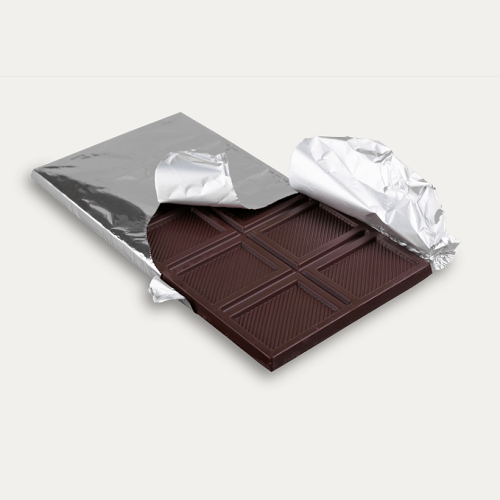Aluminum Foil Composite Paper and Film in Snack Packaging
Packaging plays a critical role in the food industry, particularly for snack products that require protection, convenience, and extended shelf life. Among the most widely used solutions is aluminum foil composite paper and film, a high-performance multilayer material engineered to provide superior barrier properties, mechanical strength, and printability.
1. The Role of Packaging in Snacks
Snack products—such as chips, biscuits, nuts, chocolates, and energy bars—are highly sensitive to moisture, oxygen, light, and aroma transfer. Even slight degradation can lead to staleness, rancidity, or loss of flavor.
Packaging must therefore achieve:
- Barrier protection: against water vapor, gases, and light.
- Mechanical integrity: to resist puncture and tearing.
- Sealability: for hygienic closure and product safety.
- Printability: to carry brand designs and nutritional information.
- Sustainability and cost-effectiveness: balancing performance with environmental impact.
Aluminum foil composite laminates combine multiple materials to meet these diverse needs.
2. Structure of Aluminum Foil Composite Laminates
Aluminum foil is rarely used alone in snack packaging because it is brittle and prone to pinholes. Instead, it is laminated with paper, plastic films, or coatings to form composites with enhanced performance.
A typical multilayer structure may look like this:
1. Outer layer (Paper or PET)
- Provides stiffness, printability, and abrasion resistance.
- Acts as a carrier for inks and coatings.
- Paper offers a natural appearance, while PET gives high gloss and strength.
2. Middle layer (Aluminum foil, 6–9 μm thick)
- Primary barrier layer against oxygen, moisture, and UV light.
- Prevents aroma loss and flavor migration.
3. Inner layer (Polyethylene or PP film)
- Provides heat-sealability.
- Protects aluminum from corrosion caused by food acids or salts.
- Ensures food contact safety.
Adhesive or extrusion lamination processes bond these layers together. Depending on product requirements, additional layers (e.g., EVOH film, metallized film, or coatings) may be incorporated.
3. Manufacturing Process
The production of aluminum foil composite paper and film typically involves:
1. Surface preparation
- Corona or flame treatment of plastic films to improve adhesion.
- Primer coating on paper for ink and adhesive anchorage.
2. Printing
- Rotogravure or flexographic printing on the outer substrate (paper or PET).
- Solvent-based, water-based, or UV-curable inks are used depending on performance needs.
3. Lamination
- Adhesive lamination: Liquid adhesives (polyurethane, acrylic) are applied and cured.
- Extrusion lamination: Molten polymer (e.g., LDPE) is extruded as a bonding layer between foil and paper/film.
4. Curing and slitting
- Laminates are wound and allowed to cure for full adhesive strength.
- Rolls are slit into specified widths for form-fill-seal packaging machines.
4. Technical Properties
Barrier Properties
- Water vapor transmission rate (WVTR): <0.01 g/m²·day for foil laminates.
- Oxygen transmission rate (OTR): <0.01 cc/m²·day.
- Light protection: Near-total opacity, preventing photo-oxidation.
Mechanical Properties
- Tensile strength: Paper/PET layers provide handling strength.
- Puncture resistance: Multi-layer design prevents tearing from sharp snack edges (e.g., chips).
Thermal and Seal Properties
- Heat seal initiation temperature: Typically 90–120 °C for LDPE layers.
- High seal strength ensures product integrity during distribution.
Printability
- Compatible with multi-color high-resolution printing.
- Surface coatings enable matte, gloss, or metallic effects.
5. Applications in Snack Packaging
Aluminum foil composites are widely used for:
- Potato chips and extruded snacks: high barrier prevents rancidity from oil oxidation.
- Biscuits and cookies: moisture barrier maintains crispness.
- Chocolate and confectionery: light and aroma barrier ensures flavor stability.
- Nuts and dried fruits: protects against oxygen-induced rancidity.
- Instant noodles and seasoning sachets: multilayer structures resist moisture and retain volatile aromas.
6. Advantages
- Excellent barrier performance: (better than metallized film alone).
- Lightweight yet effective: reducing material consumption compared to rigid packaging.
- Customizable structures: to balance cost and performance.
- High consumer appeal: with metallic shine or premium paper textures.
7. Challenges and Limitations
- Recyclability issues: Multi-material laminates are difficult to separate into pure streams.
- Foil pinholes: Very thin foil (<6 μm) may develop pinholes during processing.
- Cost: Higher than simple plastic films.
- Environmental pressure: Increasing demand for recyclable mono-material or biodegradable solutions.
8. Emerging Trends
- Metallized polymer films (e.g., metallized PET or OPP): as partial substitutes for foil in some snack categories.
- Bio-based coatings: (e.g., PLA, barrier coatings from nanocellulose) to improve sustainability.
- Ultra-thin foil laminates: with optimized barrier-to-weight ratios.
- Recyclable paper-foil alternatives: such as water-based coatings combined with fiber substrates.
Aluminum foil composite paper and film remain one of the most effective packaging materials for snacks, offering unmatched barrier properties and product protection. While recyclability and sustainability concerns are driving innovation toward alternative materials, foil laminates continue to dominate applications where long shelf life, flavor retention, and consumer appeal are paramount. Future developments will focus on eco-friendly designs without compromising the high performance that makes aluminum foil composites the gold standard in snack packaging.






























